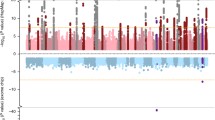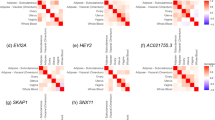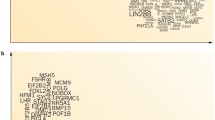Abstract
Objective
To identify novel susceptibility genes for age at natural menopause (ANM).
Methods
Using transcription data generated in tissues from normal hypothalami (n = 73) and ovaries (n = 68) and high-density genotyping data provided by the Genotype-Tissue Expression (GTEx) database, we built 16 164 genetic models to predict gene expression across the transcriptome in these tissues. We used these models and summary statistics data from genome-wide association studies (GWAS) of ANM generated in 69 360 women of European ancestry to identify genes with their predicted expression related to ANM.
Results
We found the predicted expression of 34 genes to be significantly associated with ANM at a Bonferroni-corrected threshold of P < 3.09 ×10−6. These include 4 genes located more than 1 Mb away from any previously GWAS-identified ANM-associated variants, 24 genes that reside in known GWAS-identified loci but have not been previously implicated, and 6 genes previously implicated as ANM-associated genes.
Conclusion
Results from this transcriptome-wide association study, which integrated Expression quantitative trait loci (eQTL) data with summary statistics of GWAS of ANM, improves our understanding of the genetics and biology of female reproductive aging.
Similar content being viewed by others
References
Day FR, Ruth KS, Thompson DJ, et al. Large-scale genomic analyses link reproductive aging to hypothalamic signaling, breast cancer susceptibility and BRCA1-mediated DNA repair. Nat Genet. 2015;47(11):1294–1303.
Hinds L, Price J. Menopause, hormone replacement and gynaecological cancers. Menopause Int. 2010;16(2):89–93.
Parker SE, Troisi R, Wise LA, et al. Menarche, menopause, years of menstruation, and the incidence of osteoporosis: the influence of prenatal exposure to diethylstilbestrol. J Clin Endocrinol Metab. 2014;99(2):594–601.
Qiu C, Chen H, Wen J, et al. Associations between age at menarche and menopause with cardiovascular disease, diabetes, and osteoporosis in Chinese women. J Clin Endocrinol Metab. 2013;98(4):1612–1621.
Velie EM, Nechuta S, Osuch JR. Lifetime reproductive and anthropometric risk factors for breast cancer in postmenopausal women. Breast Dis. 2005;24:17–35.
Vogel VG. Epidemiology, genetics, and risk evaluation of postmenopausal women at risk of breast cancer. Menopause. 2008;15(4 suppl):782–789.
He C, Kraft P, Chen C, et al. Genome-wide association studies identify loci associated with age at menarche and age at natural menopause. Nat Genet. 2009;41(6):724–728.
Stolk L, Zhai G, van Meurs JBJ, et al. Loci at chromosomes 13, 19 and 20 influence age at natural menopause. Nat Genet. 2009;41(6):645–647.
Stolk L, Perry JRB, Chasman DI, et al. Meta-analyses identify 13 loci associated with age at menopause and highlight DNA repair and immune pathways. Nat Genet. 2012;44(3):260–268.
Nicolae DL, Gamazon E, Zhang W, Duan S, Dolan ME, Cox NJ. Trait-associated SNPs are more likely to be eQTLs: annotation to enhance discovery from GWAS. PLoS Genet. 2010;6(4):e1000888.
Nica AC, Montgomery SB, Dimas AS, et al. Candidate causal regulatory effects by integration of expression QTLs with complex trait genetic associations. PLoS Genet. 2010;6(4):e1000895.
Albert FW, Kruglyak L. The role of regulatory variation in complex traits and disease. Nat Rev Genet. 2015;16(4):197–212.
Gamazon ER, Wheeler HE, Shah KP, et al. A gene-based association method for mapping traits using reference transcriptome data. Nat Genet. 2015;47(9):1091–1098.
Gusev A, Ko A, Shi H, et al. Integrative approaches for large-scale transcriptome-wide association studies. Nat Genet. 2016;48(3):245–252.
Zhu Z, Zhang F, Hu H, et al. Integration of summary data from GWAS and eQTL studies predicts complex trait gene targets. Nat Genet. 2016;48(5):481–487.
Pavlides JMW, Zhu Z, Gratten J, McRae AF, Wray NR, Yang J. Predicting gene targets from integrative analyses of summary data from GWAS and eQTL studies for 28 human complex traits. Genome Med. 2016;8(1):84.
Mancuso N, Shi H, Goddard P, Kichaev G, Gusev A, Pasaniuc B. Integrating gene expression with summary association statistics to identify genes associated with 30 complex traits. Am J Hum Genet. 2017;100(3):473–487.
Day FR, Thompson DJ, Helgason H, et al. Genomic analyses identify hundreds of variants associated with age at menarche and support a role for puberty timing in cancer risk. Nat Genet. 2017;49(6):834–841.
GTEx Consortium. Human genomics. The Genotype-Tissue Expression (GTEx) pilot analysis: multitissue gene regulation in humans. Science. 2015;348(6235):648–660.
McCarthy S, Das S, Kretzschmar W, et al. A reference panel of 64,976 haplotypes for genotype imputation. Nat Genet. 2016;48(10):1279–1283.
Howie BN, Donnelly P, Marchini J. A flexible and accurate genotype imputation method for the next generation of genome-wide association studies. PLoS Genet. 2009;5(6):e1000529.
Delaneau O, Marchini J, Zagury J-F. A linear complexity phasing method for thousands of genomes. Nat Methods. 2011;9(2):179–181.
DeLuca DS, Levin JZ, Sivachenko A, et al. RNA-SeQC: RNA-seq metrics for quality control and process optimization. Bioinforma Oxf Engl. 2012;28(11):1530–1532.
Stegle O, Parts L, Piipari M, Winn J, Durbin R. Using probabilistic estimation of expression residuals (PEER) to obtain increased power and interpretability of gene expression analyses. Nat Protoc. 2012;7(3):500–507.
Guo X, Lin M, Rockowitz S, Lachman HM, Zheng D. Characterization of human pseudogene-derived non-coding RNAs for functional potential. PloS One. 2014;9(4):e93972.
Barbeira A, Shah KP, Torres JM, et al. MetaXcan: summary statistics based gene-level association method infers accurate predixcan results. bioRxiv. 2016; https://doi.org/10.1101/045260
Krämer A, Green J, Pollard J, Tugendreich S. Causal analysis approaches in Ingenuity Pathway Analysis. Bioinforma Oxf Engl. 2014;30:523–530.
Yang J, Ferreira T, Morris AP, Genetic Investigation of ANthropometric Traits (GIANT) Consortium; DIAbetes Genetics Replication And Meta-analysis (DIAGRAM) Consortium, et al. Conditional and joint multiple-SNP analysis of GWAS summary statistics identifies additional variants influencing complex traits. Nat Genet. 2012;44(4):369–375, S1–S3.
Shiratori A, Okumura K, Nogami M, et al. Assignment of the 49-kDa (PRIM1) and 58-kDa (PRIM2A and PRIM2B) subunit genes of the human DNA primase to chromosome bands 1q44 and 6p11.1-p12. Genomics. 1995;28(2):350–353.
Hattori N, Fujiwara H, Maeda M, Fujii S, Ueda M. Epoxide hydrolase affects estrogen production in the human ovary. Endocrinology. 2000;141(9):3353–3365.
Sang Q, Li X, Wang H, et al. Quantitative methylation level of the EPHX1 promoter in peripheral blood DNA is associated with polycystic ovary syndrome. PloS One. 2014;9(2):e88013.
Cerk S, Schwarzenbacher D, Adiprasito JB, et al. Current status of long non-coding RNAs in human breast cancer. Int J Mol Sci. 2016;17(9). pii: E1485.
Evans JR, Feng FY, Chinnaiyan AM. The bright side of dark matter: lncRNAs in cancer. J Clin Invest. 2016;126(8):2775–2782.
Sudlow C, Gallacher J, Allen N, et al. UK biobank: an open access resource for identifying the causes of a wide range of complex diseases of middle and old age. PLoS Med. 2015;12(3):e1001779.
Chapman C, Cree L, Shelling AN. The genetics of premature ovarian failure: current perspectives. Int J Womens Health. 2015;7:799–810.
Rossetti R, Ferrari I, Bonomi M, Persani L. Genetics of primary ovarian insufficiency. Clin Genet. 2017;91(2):183–198.
Shelling AN. Premature ovarian failure. Reprod Camb Engl. 2010;140(5):633–641.
Author information
Authors and Affiliations
Corresponding author
Additional information
Authors’ Note
Jiajun Shi, PhD, and Lang Wu, PhD, contributed equally to this study.
X.O.S. and W.Z. conceived the study. L.W. and J.S. contributed to the study design and performed the statistical analyses. J.S. and L.W. drafted the manuscript with significant contributions from X.O.S. and W. Z. Y. L. contributed to the model building. X.G. contributed to the pathway analyses. All authors provided suggestions during the data analyses, participated in data interpretation, and critically reviewed and approved the final manuscript.
The Genotype-Tissue Expression (GTEx) Project data were obtained from the GTEx Portal (https://www.gtexportal.org/home/datasets). Institution of Research: Vanderbilt University School of Medicine.
Rights and permissions
About this article
Cite this article
Shi, J., Wu, L., Li, B. et al. Transcriptome-Wide Association Study Identifies Susceptibility Loci and Genes for Age at Natural Menopause. Reprod. Sci. 26, 496–502 (2019). https://doi.org/10.1177/1933719118776788
Published:
Issue Date:
DOI: https://doi.org/10.1177/1933719118776788




